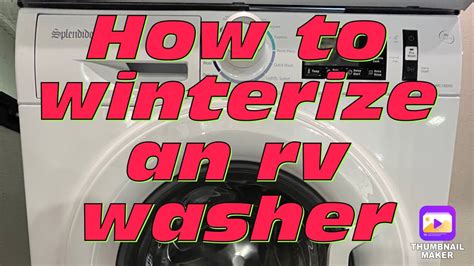How To Winterize Rv Washer
Ronan Farrow
Apr 03, 2025 · 3 min read

Table of Contents
How to Winterize Your RV Washer: A Comprehensive Guide
Winterizing your RV is crucial to preventing costly damage from freezing temperatures. While many focus on plumbing and tanks, the RV washer often gets overlooked. This comprehensive guide will walk you through the essential steps to properly winterize your RV washer, ensuring it remains in top condition until spring.
Understanding the Risks of Freezing
Water left inside your RV washer during freezing temperatures can expand, causing significant damage to the hoses, pump, and other internal components. This can lead to costly repairs or even necessitate a complete washer replacement. Preventing this damage is far easier and more economical than dealing with the consequences.
Step-by-Step Winterization Process
The exact steps may vary slightly depending on your specific RV washer model, but the general process remains consistent. Always consult your owner's manual for detailed instructions specific to your machine.
1. Disconnect from Power and Water
Begin by unplugging your RV washer from the power source. This is a critical safety precaution. Next, disconnect the water supply hoses from both the inlet and outlet of the washer.
2. Drain Remaining Water
Completely drain any residual water from the washer. Most RV washers have a drain pump or a drain hose. Use this to remove all standing water. Pay close attention to any low points where water might collect.
3. Blow Out Remaining Water with Compressed Air
To ensure all water is removed, use a compressor and blow compressed air through the water inlet and outlet hoses. This process is highly effective in removing any lingering water droplets that might otherwise freeze. Be sure to use low pressure to avoid damage.
4. Add RV Antifreeze (Optional but Recommended)
While draining and blowing out the water is often sufficient, adding RV antifreeze provides an extra layer of protection. Pour a small amount of RV antifreeze directly into the washer's inlet and outlet. This will coat the interior components and provide additional insurance against freezing.
5. Store Appropriately
Finally, store your RV washer in a cool, dry place. If storing the washer inside the RV, consider placing it in an area that is less prone to freezing.
Frequently Asked Questions (FAQs)
Q: What type of antifreeze should I use?
A: Always use RV antifreeze, specifically designed for this purpose. Automotive antifreeze is toxic and should never be used in RV systems.
Q: How often should I winterize my RV washer?
A: Winterization is necessary whenever temperatures are expected to drop below freezing (0°C or 32°F).
Q: Can I leave my RV washer connected to the water supply during winter?
A: No. Leaving it connected significantly increases the risk of freezing and damage.
Q: My washer has a built-in drain pump; do I still need to blow air through the lines?
A: While a drain pump removes most water, blowing out the lines with compressed air is still recommended to ensure complete water removal.
Conclusion
Properly winterizing your RV washer is a simple yet essential step in protecting your investment. By following these steps, you can significantly reduce the risk of damage and ensure your washer is ready to go when spring arrives. Remember to always consult your owner's manual for specific instructions relevant to your RV washer model. Taking these precautions now can save you significant time and money in the long run.
Featured Posts
Also read the following articles
| Article Title | Date |
|---|---|
| Judgement How Someone Feels About You | Apr 03, 2025 |
| How To Use Spray Wax On Car | Apr 03, 2025 |
| How Big Does A Mechanical Room Need To Be | Apr 03, 2025 |
| How Big Is 9x11 | Apr 03, 2025 |
| After Paying Bond How Long Does It Take To Release | Apr 03, 2025 |
Latest Posts
-
How High Are You Test
Apr 04, 2025
-
How Heavy Is A Side By Side
Apr 04, 2025
-
How Heavy Is A Gearbox
Apr 04, 2025
-
How Heavy Is A Car Door
Apr 04, 2025
-
How Heavy Are Jeep Doors
Apr 04, 2025
Thank you for visiting our website which covers about How To Winterize Rv Washer . We hope the information provided has been useful to you. Feel free to contact us if you have any questions or need further assistance. See you next time and don't miss to bookmark.
